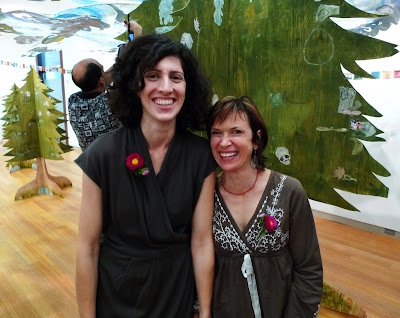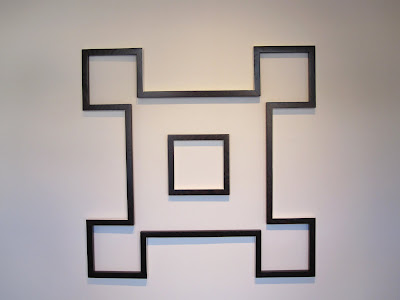
Notes To Nonself, currently on view at Herron Galleries in Indianapolis, is an incredible journey through the passageways of self-hood by artists Diane Christiansen and Soshanna Utchenik, both originally from Chicago. They aptly describe the exhibition, which was first installed at Chicago's Hyde Park Art Center, as a "metaphoric landscape for the activity of the mind." The exhibition's immersive environment is composed of an ego forest rife with clouds, an octopus of attachment, a campsite that cannot be entered, a meditation center/clubhouse that visitors may utilize, a video installation, and strings of prayer flags to which viewers are invited to add their own flags containing positive intentions. "The areas are things you get hooked on, things your mind gets hooked on and obsesses on," Christiansen explains. The octopus, for example, represents attachment: relational, body image, and attachment to youth. Each tree in the ego forest represents a false duality such as isolation/connection and sloth/activity.





The cohesion between the two artists is almost startling to witness in real time; they regularly complete each other's thoughts and interact with the outside world very much as one unit. The pair met when Utchenik was introduced to Christiansen on the pretext that she might be able to help her create a giant cartoon character of Christiansen's design out of paper machete. When Utchenik moved to Slovenia, she reached out to Christiansen and the two began a friendship that developed through physically mailing small notes and pieces of ephemera to each other as well as contact through Skype and other online means. These same notes blossomed into Notes To Nonself, and most of them are integrated as collages into the trees of the ego forest. "Some of our worldviews are very shockingly similar and hilariously so, and so we started seeing the world and each other and ourselves in these notes, sort of colliding, and we hadn't really known each other before." Christiansen muses. "Once we saw this accumulation and the potential for continuing that process of communicating visually through materials, we were like 'OK, let's propose putting this together in a space,'" Utchenik adds.


The artists describe the coming together of Notes To Nonself as "slapdash." "When she says slapdash, that really alludes to a whole world of people coming together to gather all these elements, and not necessarily quick, but just rough...the notes are very precise in terms of personal moments captured...the actual construction was very rough, and really reliant on faith, on just believing that this would come together with one person helping us with this thing, and one person helping us with another and faith also that we should make this, because it is a crazy scale considering that when we began the process we didn't have any support or financial support," the artists explain. The materials they used to construct the different parts of the exhibition are quite unique: bamboo, paper machete, tape, plywood and fishing wire. "Nonself" refers to a lack of solidity and the interconnectedness not only of beings but of everything. Notes To Nonself's iconology, including the video, feature "peculiar landscapes filled with trees, skulls and distinctive cartoon figures and animals," to quote the exhibition catalog; Christiansen's recent drawing and painting work are heavily influential here, and it is important to note that the skulls are a Tibetan reference and symbolize the death of the ego.



Notes To Nonself is a decidedly quirky exercise in exploring human truths, relationships, and ideas of self and ego. Navigating through the exhibition necessitates some level of interaction with all of its different parts; this is not a series of flat works on walls or 3D works on pedestals but a complete environment that must be grappled with. It is deeply personal, yet the artists have succeeded in making a personal statement that forces viewers to have their own reckonings about ego, self-hood and the human experience.
 A still image from the video in the exhibition
A still image from the video in the exhibition













































